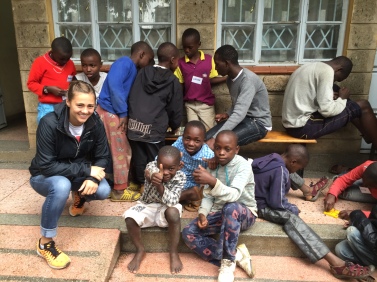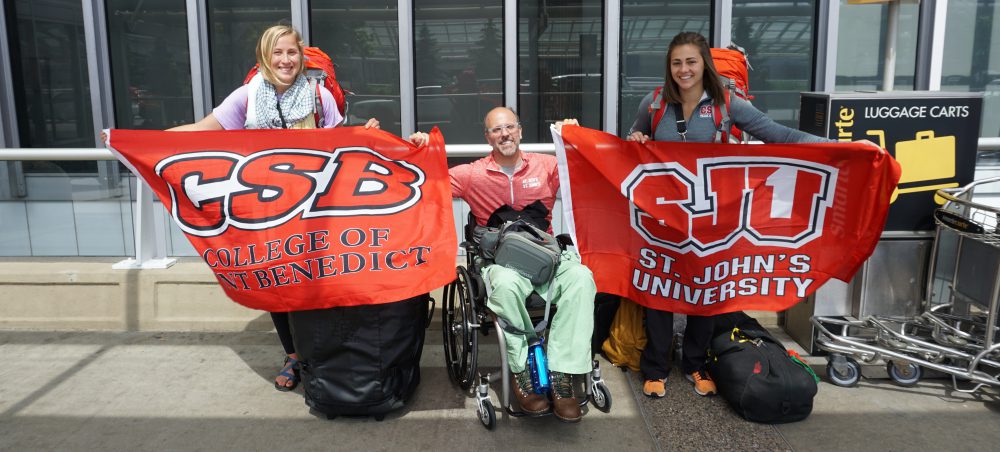Jambo! Karibu! Ni date disi!
Hello! Welcome! Bring me a banana! (Just trying to get the hang of Swahili)
Hannah, Bob, and I have made it through our first week in Kenya! Over the past 8 or so days since we arrived we have already met so many amazing people and done so much, it feels as though we have been here much longer. A short highlight reel (in no specific order) would include:
- Going to the rural town of Nunguni and meeting up with a man named Peter who has had 3 children attend CSB/SJU. We were able to attend church with him, visit a home for children with disabilities that he is involved with, and join him and his family for lunch.
- Visiting a daycare for street boys called Mododo in the Mathare slum (2nd largest slum in Kenya) with two German volunteers who are also staying in the monastery guest house.

- Tagging along with a volunteer from Australia, who has been here in Kenya for the past 4 years, to Mother Theresa’s- a compound that includes a school, a home for women with disabilities, a home for children with disabilities (who they refer to as “special kids”), and a home for mothers and children who had been living on the street. Bob, Hannah, and I were able to help feed the “special kids,” and have since gone back a second time to help out again.
- Serving food at a soup kitchen in Pangani. The soup kitchen is run by the brothers of Mother Theresa (the sisters run the home for special kids). It was amazing how respectful all the men were who came to get food- they even stayed before and after to sing and pray. Though I am sure their respect is due largely to the amazing brothers who work there who seemed to just radiate joy.
- Eating dinner with the Benedictine sisters. The food was amazing, and the company was even better. When we left, all of the sisters (around 10 of them) walked us home joking that they were “nuns on the run” and that it was “nuns night out!”
“Our attitudes towards people with disabilities may be our biggest handicap.”
Through visiting different homes for children and adults with disabilities, as well as simply through experiencing Kenya with Bob, I have also been able to get a glimpse into how people with disabilities are treated in Kenya.
From the moment we arrived, it was clear that much of Nairobi was not built with wheelchair accessibility in mind. With few exceptions, there is a noticeable lack of curb cuts and ramps, and many doorways and sidewalks are too narrow to fit through. For many people with disabilities in Kenya, however, navigating through narrow entries and over curbs is the least of their concerns.
While visiting the homes for children with disabilities in Nunguni and the Mathare slum in Nairobi, we learned that children with disabilities may be seen as cursed, or at the least, a heavy burden. As a result, children may be abandoned, left to fend for themselves on the streets, or even killed. These children struggle to even be seen as human.
Luckily, there are people and organizations in Kenya that are working to change that. In Nunguni, we visited a center that was created to house children with disabilities from all around the surrounding rural area. The home is built right next to the school so that these children who otherwise would not have been able to make the walk to school can receive an education. The children are also brought to church every Sunday and made a part of the community in an attempt to change people’s view of disabilities. While we were there, Bob had the chance to speak with the children and show them how, as a person with a disability just like them, he was able to get a law degree, become a professor, and travel in an airplane from the United States to Kenya. He told these kids that if they want the laws in Kenya to change, they had the power to make it happen.
We also had the opportunity to visit a home for children with disabilities in the Mathare slum in Nairobi. The center is home to 49 “special kids,” many with severe mental and physical disabilities, and is run by the sisters of Mother Theresa. The complex disabilities of many of the children there would be a difficult task for any parent or caretaker to care for, as would the sheer task of running a center for nearly 50 children. Yet, these children seemed to be incredibly well taken care of. They were well-fed, and have clean clothes; and the site even had standers, and other equipment for physical therapy. Still, it is hard to imagine that every child is able to be loved and receive the attention he or she might by a family of their own; rather than in a center full of children. I can only hope that with time, through the efforts of organizations like the ones we visited, or other people challenging the laws and customs, that people with disabilities in Kenya may have a better life and greater opportunities- to be kept and loved by their families, to be able to navigate their streets and shops, and to have access to the same educational and career opportunities as any other Kenyan.
Finally, if you want to hear a great message and put a smile on your face, check out these two videos by the L’Arche community of Kenya. L’Arche International is organization working to improve the lives of people with disabilities in over 50 countries around the world. These videos were shown to me by another volunteer staying at the monastery guest house; I promise they’ll be worth a few minutes of your time!
Kwa heri! Tu o nani badaai! Hakuna matata, rafiki!
Goodbye! See you later! No worries, friend!






Great stuff, Piper! Wonderful videos! May you come by many bananas and more great experiences in Kenya.
LikeLiked by 1 person
Thanks for the update! So happy to hear you are having a great time! Here’s to happy and safe travels continuing….
LikeLike